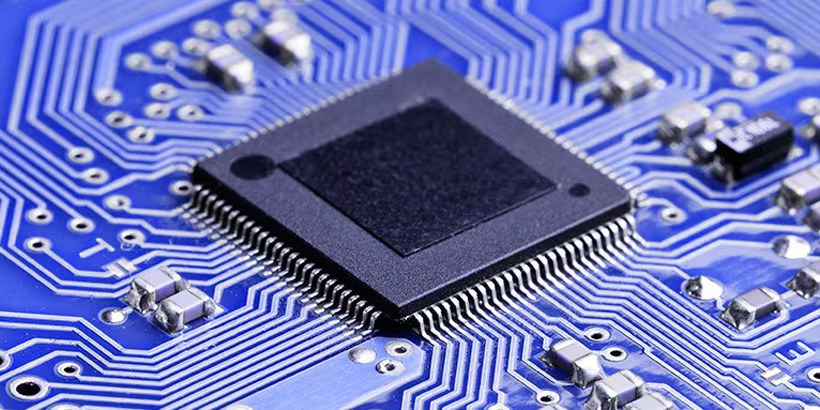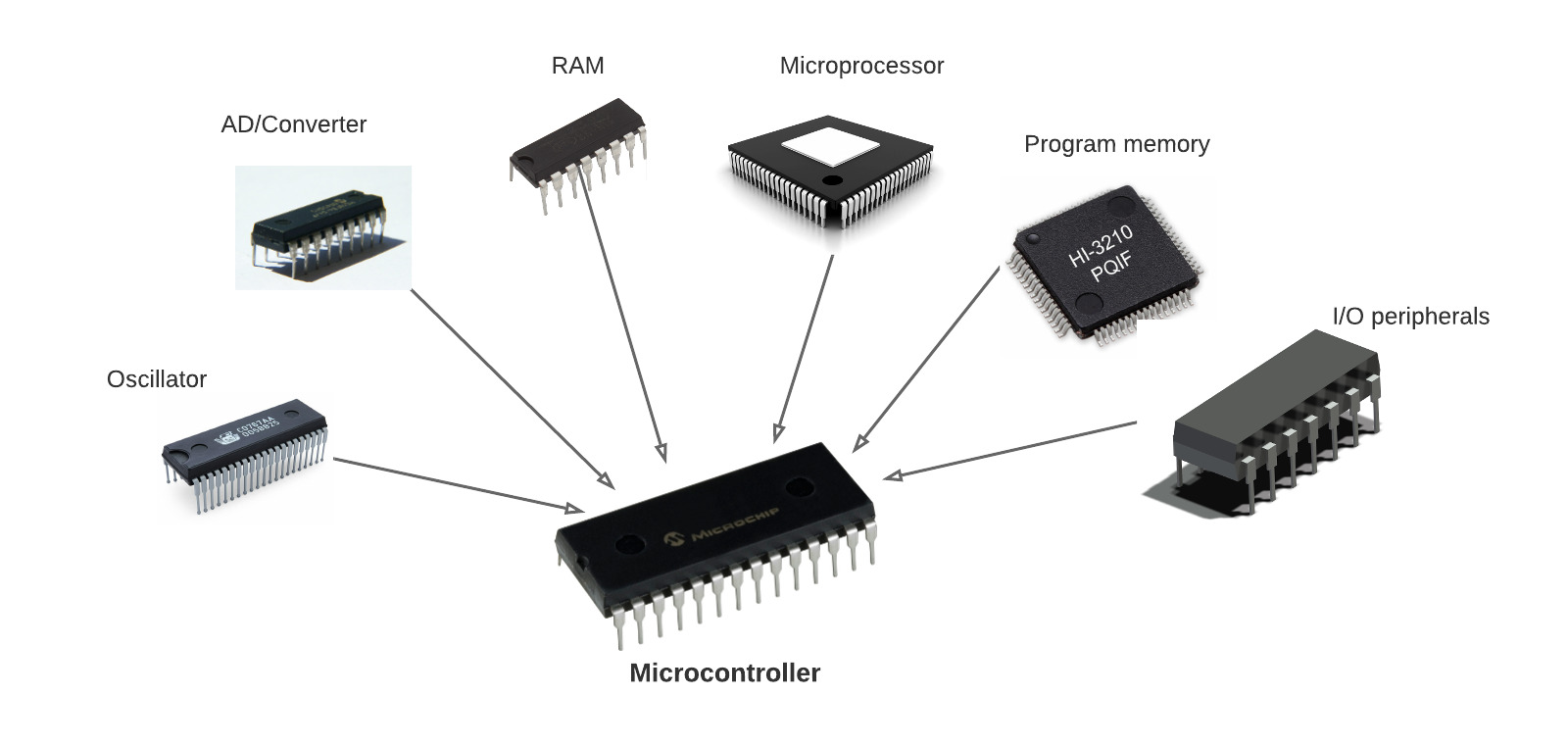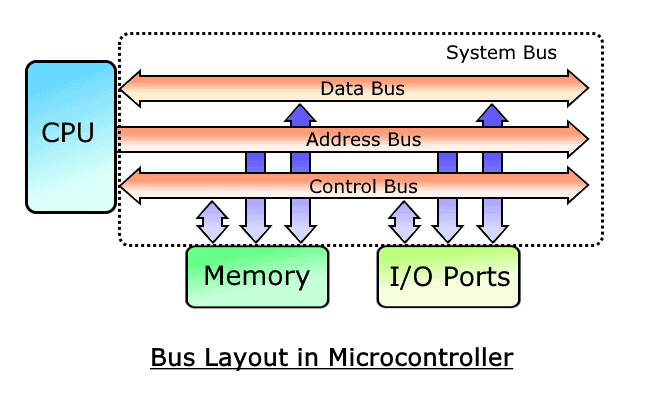A microcontroller is a compact integrated circuit that contains a processor core, memory, and programmable input/output peripherals. Microcontrollers are designed for embedded applications where a single chip can control various functions within a system. Here are key points about microcontrollers:

Components of a Microcontroller:
-
Processor Core: The central processing unit (CPU) executes instructions and performs calculations.
-
Memory: Includes read-only memory (ROM) for storing firmware and random-access memory (RAM) for temporary data storage.
-
Input/Output Peripherals: Analog-to-digital converters, digital I/O pins, timers, communication interfaces (e.g., UART, SPI, I2C), and other peripherals enable interaction with external devices.
Features of Microcontrollers:
-
Single-Chip Solution: Combines CPU, memory, and I/O peripherals on a single chip for compact and cost-effective designs.
-
Low Power Consumption: Designed for battery-powered and energy-efficient applications.
-
Real-Time Processing: Capable of responding to real-time events and performing tasks with precise timing.
-
In-Circuit Programming: Allows firmware updates and reprogramming without removing the microcontroller from the circuit.
-
Versatile Applications: Used in various applications, including automotive systems, consumer electronics, industrial automation, IoT devices, and more.
Microcontroller Families:
-
8-bit: Simple and cost-effective controllers suitable for basic tasks.
-
16-bit: Offer higher performance and capabilities compared to 8-bit controllers.
-
32-bit: Provide greater processing power, memory, and advanced features for complex applications.
Programming Microcontrollers:
-
Embedded C: Commonly used programming language for microcontrollers.
-
Integrated Development Environments (IDEs): Software tools like Arduino IDE, MPLAB X IDE, and Keil uVision facilitate microcontroller programming.
-
Firmware Development: Involves writing code to control the microcontroller's behavior and interact with external devices.
Applications of Microcontrollers:
-
Automotive: Engine control units, dashboard displays, and safety systems.
-
Consumer Electronics: Smart home devices, wearables, and appliances.
-
Industrial Automation: PLCs, motor control, monitoring systems, and robotics.
-
IoT Devices: Connected sensors, smart meters, and data loggers.
-
Medical Devices: Patient monitoring systems, diagnostic tools, and medical instruments.
Microcontrollers play a crucial role in modern electronic systems, providing intelligence and control capabilities in a wide range of applications. Their versatility, compact size, and low power consumption make them ideal for embedded systems that require intelligent control and data processing.

Types of microcontroller
Microcontrollers come in various types and architectures to cater to different requirements and applications. Here are some common types of microcontrollers based on their architecture and features:
1. 8-bit Microcontrollers:
- Features: Simple architecture with an 8-bit data bus and ALU (Arithmetic Logic Unit).
- Examples: Atmel AVR, Microchip PIC, 8051, Intel MCS-51 series.
- Applications: Basic embedded applications, consumer electronics, automotive systems, household appliances.
2. 16-bit Microcontrollers:
- Features: Higher performance, larger memory space, and improved peripherals compared to 8-bit microcontrollers.
- Examples: Microchip PIC24, Renesas RX100 series, Freescale Kinetis K series.
- Applications: Industrial automation, medical devices, portable instruments, communication systems.
3. 32-bit Microcontrollers:
- Features: Increased processing power, larger memory capacity, and advanced peripherals.
- Examples: ARM Cortex-M series, Atmel SAM series, Renesas RX600 series.
- Applications: High-performance embedded systems, IoT devices, automotive control systems, robotics.
4. ARM Microcontrollers:
- Features: Based on the ARM architecture, offering a wide range of performance levels and capabilities.
- Examples: ARM Cortex-M0, Cortex-M3, Cortex-M4, Cortex-M7.
- Applications: Diverse applications ranging from low-power sensors to high-performance computing.
5. Digital Signal Controllers (DSCs):
- Features: Blend of microcontroller and digital signal processing (DSP) capabilities for handling signal processing tasks.
- Examples: Microchip dsPIC series, TI C2000 series.
- Applications: Audio processing, motor control, power management, communication systems.
6. RISC vs. CISC Microcontrollers:
- Reduced Instruction Set Computer (RISC): Simplified instruction set for faster and more efficient processing.
- Complex Instruction Set Computer (CISC): Instruction-rich architecture with complex commands for versatile operation.
7. Specialized Microcontrollers:
- Application-Specific Microcontrollers: Customized for specific applications like automotive control units, motor controllers, and industrial automation.
- Security Microcontrollers: Equipped with security features like encryption, secure boot, and tamper detection for secure applications.
8. Low-Power Microcontrollers:
- Ultra-Low-Power Microcontrollers: Designed for battery-operated devices and IoT applications to minimize power consumption and extend battery life.
Microcontrollers come in diverse types to cater to a wide range of applications, offering various performance levels, features, and capabilities to meet specific design requirements and constraints.

What is the difference between a microcontroller and a microprocessor?
Microcontrollers and microprocessors are both computing devices but have key differences in terms of their architecture, features, and applications. Here are the main distinctions between microcontrollers and microprocessors:
Microcontroller:
- Integrated System:
- A microcontroller is a compact integrated circuit that includes a processor core, memory (ROM and RAM), and input/output peripherals on a single chip.
- On-Chip Peripherals:
- Microcontrollers have built-in peripherals like analog-to-digital converters (ADC), timers, communication interfaces (UART, SPI, I2C), and digital I/O ports.
- Application Specific:
- Designed for specific applications requiring control functions in embedded systems, IoT devices, consumer electronics, and more.
- Low Power:
- Typically optimized for low power consumption, making them suitable for battery-powered and energy-efficient applications.
Microprocessor:
- Stand-Alone Processing Unit:
- A microprocessor is a standalone processing unit that requires external support chips for memory, input/output, and other functions.
- General-Purpose:
- Designed for general computing tasks in personal computers, servers, workstations, and high-performance systems.
- High Performance:
- Microprocessors focus on processing power, executing complex instructions, and handling multitasking operations efficiently.
- No On-Chip Peripherals:
- Microprocessors do not have integrated peripherals like microcontrollers and rely on external devices for I/O functions.
Key Differences:
-
Integration: Microcontrollers integrate CPU, memory, and peripherals on a single chip, while microprocessors primarily focus on processing power and require external components for peripherals.
-
Application Focus: Microcontrollers are application-specific, ideal for embedded systems and control applications, whereas microprocessors are used in general-purpose computing tasks.
-
Peripherals: Microcontrollers have on-chip peripherals essential for embedded applications, whereas microprocessors rely on external devices for interfacing.
-
Power Consumption: Microcontrollers are designed for low power consumption, making them suitable for battery-powered applications, while microprocessors focus more on performance.
Examples:
- Microcontroller: Atmel AVR, Microchip PIC, ARM Cortex-M series.
- Microprocessor: Intel x86 series, AMD Ryzen series, ARM Cortex-A series.
In summary, the main difference between microcontrollers and microprocessors lies in their integration level, application focus, peripheral availability, and power consumption characteristics. Microcontrollers are commonly used in embedded systems requiring integrated control functions, while microprocessors excel in general-purpose computing tasks demanding high processing power and versatility.

Frequently Asked Questions
1、What is a microcontroller used for?
Microcontrollers are versatile integrated circuits utilized in a wide variety of applications that require intelligent control, data processing, and interfacing with peripheral devices. Here are some common uses of microcontrollers across various industries:
1. Embedded Systems:
- Consumer Electronics: Smartphones, digital cameras, gaming consoles, smart TVs, wearable devices.
- Home Appliances: Microwave ovens, washing machines, refrigerators, air conditioners.
- Smart Home Devices: Thermostats, smart lighting systems, security cameras, door locks.
2. Automotive Industry:
- Engine Control: Fuel injection systems, ignition timing control, cruise control.
- Safety Systems: Anti-lock braking systems (ABS), airbag deployment systems, tire pressure monitoring.
- In-Vehicle Infotainment: Audio systems, navigation systems, touch screens.
3. Industrial Automation:
- PLCs (Programmable Logic Controllers): Automated manufacturing processes, conveyor systems, robotics.
- Motor Control: Variable speed drives, servo motors, stepper motor controllers.
- Sensors and Monitoring: Temperature sensors, pressure sensors, level sensors, data loggers.
4. Communications:
- Networking Equipment: Routers, switches, modems, wireless access points.
- IoT Devices: Smart sensors, wearable devices, connected appliances, home automation systems.
- Mobile Devices: Microcontrollers are used in power management, touch screen interfaces, audio processing, and more.
5. Medical Devices:
- Patient Monitoring Systems: Heart rate monitors, blood pressure monitors, glucose meters.
- Diagnostic Equipment: Imaging systems, blood analyzers, ECG devices.
- Medical Instruments: Surgical tools, infusion pumps, ventilators.
6. Aerospace and Defense:
- Guidance Systems: Flight control systems, autopilots, UAVs (Unmanned Aerial Vehicles).
- Missile Systems: Navigation systems, target tracking.
- Military Equipment: Radar systems, communication devices, control systems.
7. Educational and Hobbyist Projects:
- Arduino and Raspberry Pi Projects: DIY electronics projects, robotics, home automation, and IoT prototypes.
- Learning and Teaching: Microcontrollers are a common tool for teaching programming, electronics, and embedded systems concepts.
8. Energy Management:
- Power Electronics: Inverters, converters, battery management systems.
- Smart Grid Systems: Microgrids, energy metering, solar power systems.
9. Security Systems:
- Access Control Systems: Biometric readers, RFID systems, smart locks.
- Surveillance Systems: Cameras, motion detectors, alarms.
Microcontrollers play a critical role in enabling automation, intelligence, and connectivity in countless devices and systems, contributing to the advancement of technology across multiple industries. Their compact size, low power consumption, and versatile capabilities make them indispensable in modern electronic applications.

2、What are examples of microcontrollers?
There are numerous microcontroller families available in the market, each with its own features, architecture, and applications. Here are some well-known examples of microcontroller families widely used across different industries:
1. Atmel AVR:
- Description: Known for their simplicity and ease of use, suitable for hobbyists, students, and professionals alike.
- Popular Models: ATmega328, ATmega2560.
- Applications: Arduino boards, consumer electronics, home automation.
2. Microchip PIC:
- Description: Offers a wide range of microcontrollers with various features and capabilities.
- Popular Models: PIC16, PIC18, PIC32.
- Applications: Embedded systems, automotive electronics, industrial control.
3. STMicroelectronics STM32:
- Description: ARM Cortex-M based microcontrollers providing high performance and versatility.
- Popular Models: STM32F4, STM32F7.
- Applications: IoT devices, industrial control, robotics, automotive systems.
4. Texas Instruments MSP430:
- Description: Low-power microcontrollers suitable for battery-operated applications.
- Popular Models: MSP430G2, MSP430FR.
- Applications: Wearable devices, sensor nodes, energy-efficient systems.
5. Renesas RX Series:
- Description: Offers high-performance microcontrollers suitable for advanced applications.
- Popular Models: RX100, RX600.
- Applications: Automotive control, industrial automation, medical devices.
6. NXP Semiconductors LPC Series:
- Description: ARM-based microcontrollers with a focus on connectivity and security.
- Popular Models: LPC1768, LPC546.
- Applications: IoT devices, smart home automation, industrial networking.
7. Arduino Boards:
- Description: Development boards based on various microcontroller families, including Atmel AVR and ARM Cortex-M.
- Popular Models: Arduino Uno, Arduino Mega, Arduino Due.
- Applications: Prototyping, educational projects, DIY electronics.
8. Espressif Systems ESP8266/ESP32:
- Description: WiFi and Bluetooth-enabled microcontrollers used for IoT applications.
- Popular Models: ESP8266, ESP32.
- Applications: IoT devices, home automation, embedded web servers.
9. Raspberry Pi Pico:
- Description: Microcontroller board powered by the RP2040 chip, designed for embedded projects.
- Applications: Robotics, automation, IoT projects, educational purposes.
10. TI C2000 Series:
- Description: Digital signal controllers (DSCs) for real-time control applications.
- Popular Models: TMS320F28379D, TMS320F28027.
- Applications: Motor control, power conversion, renewable energy systems.
These are just a few examples of the diverse range of microcontrollers available in the market, catering to different requirements and applications across various industries. Each microcontroller family comes with its own set of features, performance levels, and development tools to support a wide array of projects and products.
3、Is Arduino a microcontroller?
Arduino is not a microcontroller itself; rather, it is a popular open-source platform consisting of both hardware and software components. At the heart of Arduino boards, you will find a microcontroller chip. The most commonly used microcontroller on Arduino boards is the ATmega series, particularly the ATmega328 on Arduino Uno boards and the ATmega2560 on Arduino Mega boards.
In essence, an Arduino board includes a microcontroller, along with other components such as voltage regulators, crystal oscillators, USB interface, and input/output pins, all integrated into a single board. The key components of an Arduino setup are:
-
Microcontroller: The core brain that runs the programs and performs tasks based on the input it receives.
-
Hardware Interface: Components that allow communication between the microcontroller and external devices, such as USB ports, power regulators, LEDs, etc.
-
Input/Output Pins: These pins enable the microcontroller to interact with external devices like sensors, actuators, displays, and more.
Arduino is renowned for its user-friendly development environment, which includes an integrated development environment (IDE) that simplifies programming for the microcontroller. Arduino IDE uses the Wiring programming language based on C/C++ to create and upload code to the microcontroller on the Arduino board.
In summary, while Arduino itself is not a microcontroller, it is a platform that simplifies the process of working with microcontrollers, providing an accessible way for hobbyists, students, and professionals to create interactive electronic projects, prototypes, and products using microcontroller technology.
4、What is the difference between Arduino and microcontroller?
Arduino vs. Microcontroller:
Arduino:
-
Platform: Arduino is an open-source electronics platform that consists of both hardware (microcontroller board) and software (Arduino IDE).
-
Ease of Use: Arduino simplifies the process of working with microcontrollers by providing a user-friendly environment for programming and prototyping.
-
Development Environment: Arduino IDE uses the Wiring programming language (based on C/C++) to write and upload code to the microcontroller on the Arduino board.
-
Integrated Components: Arduino boards integrate a microcontroller chip (e.g., ATmega series) along with other components like voltage regulators, USB interface, and input/output pins.
-
Community Support: Arduino has a large and active community that shares projects, code examples, and provides support for users at all levels.
Microcontroller:
-
Component: A microcontroller is a standalone integrated circuit that contains a processor core, memory, input/output peripherals, and other components on a single chip.
-
Versatility: Microcontrollers are used in a wide range of applications beyond Arduino, including industrial automation, automotive systems, consumer electronics, medical devices, and more.
-
Programming: Microcontrollers can be programmed using various development environments and programming languages, with assembly language and C/C++ being common choices.
-
Customization: Microcontrollers offer more flexibility and customization options as they can be used in diverse applications with different requirements.
-
Complexity: Working directly with microcontrollers requires more technical expertise compared to using the Arduino platform.
Differences Summarized:
-
Arduino is a user-friendly platform that simplifies working with microcontrollers, targeting beginners, hobbyists, and educators.
-
Microcontrollers are standalone integrated circuits that power a wide range of electronic devices and systems, offering more flexibility and customization options.
In essence, Arduino makes using microcontrollers more accessible and beginner-friendly, while microcontrollers, in general, provide greater flexibility and control for a broader range of electronic projects and applications.
5、What are the disadvantages of microcontrollers?
While microcontrollers offer numerous advantages, they also come with certain disadvantages that can affect their use in certain applications. Some of the disadvantages of microcontrollers include:
-
Limited Processing Power: Microcontrollers are designed for specific tasks and may not have the processing power of more general-purpose computing devices like microprocessors. This limitation can impact performance in some applications.
-
Limited Memory: Microcontrollers typically have limited on-chip memory, including both ROM for program storage and RAM for data storage. This limitation can constrain the complexity of programs that can be executed.
-
Limited Input/Output Pins: The number of input/output pins available on a microcontroller is finite, which may limit the number of peripherals that can be interfaced with the device directly.
-
Less Flexibility: Microcontrollers are often application-specific and may not offer the same level of flexibility as general-purpose microprocessors. Modifying their functionality or repurposing them for different applications can be challenging.
-
Complex Programming: Writing code for microcontrollers can be more challenging compared to higher-level programming on traditional computers. It often involves dealing with low-level hardware details and constraints.
-
Debugging Challenges: Debugging embedded systems based on microcontrollers can be more challenging due to limited debugging capabilities, especially in real-time applications.
-
Cost: While microcontrollers are generally cost-effective solutions for embedded applications, high-end microcontrollers with advanced features may be more expensive, impacting the overall project cost.
-
Complex Development Environment: Setting up a development environment for programming microcontrollers can be complex, especially for beginners who are not familiar with embedded systems development.
-
Compatibility Issues: Different microcontrollers may have varying architectures, instruction sets, and development tools, leading to compatibility issues when using them across different projects.
-
Power Consumption: While microcontrollers are known for their low power consumption, some applications may require even lower power consumption, necessitating additional power-saving techniques.
Despite these disadvantages, microcontrollers remain integral components in a wide range of applications, offering efficient and cost-effective solutions for embedded systems that require intelligence, control, and real-time processing capabilities. It's important to consider these limitations when selecting a microcontroller for a specific project to ensure it aligns with the requirements and constraints of the application.



